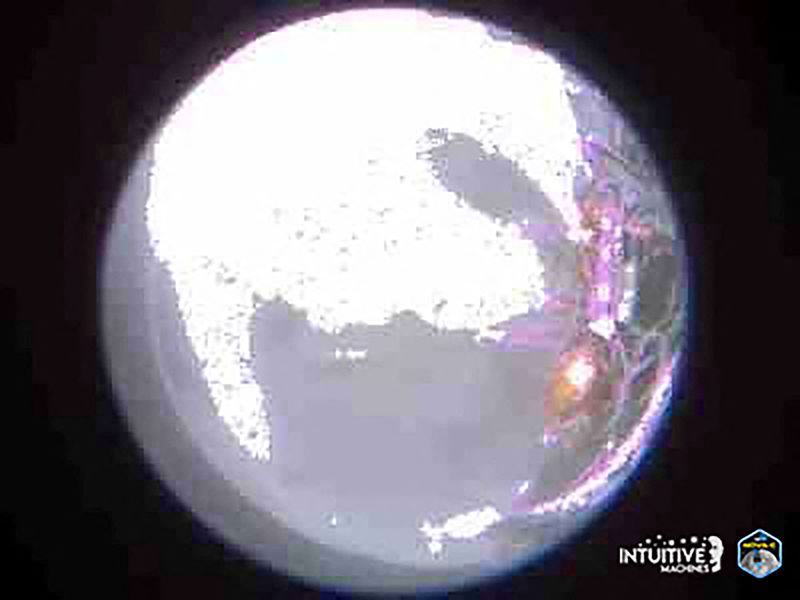By Steve Gorman and Joey Roulette
(Reuters) -Flight control engineers expect to lose contact with the private U.S. moon lander Odysseus on Tuesday morning, cutting short the mission five days after its sideways touchdown, the company behind the spacecraft, Intuitive Machines, said on Monday.
It remained to be seen how much scientific data might be lost as a result of the shortened lifespan of Odysseus, which according to previous estimates from the company and its biggest customer, NASA, was supposed to operate on the moon for seven to 10 days.
The company's forecast for a premature end to the mission came as new details emerged about testing shortcuts and human error that led to an in-flight failure of the spacecraft's laser-guided range finders ahead of its landing last Thursday near the moon's south pole.
An Intuitive Machines official said the loss of the range finders stemmed from the company's decision to forgo a test firing of the laser system to save time and money during pre-flight checks of Odysseus at NASA's Kennedy Space Center in Florida.
"There were certainly things we could've done to test it and actually fire it. They would've been very time-consuming and very costly," Mike Hansen, the company's head of navigation systems, told Reuters in an interview on Saturday. "So that was a risk as a company that we acknowledged and took that risk."
On Friday Intuitive Machines had disclosed that the laser range finders - designed to feed altitude and forward-velocity readings to Odysseus' autonomous navigation system - were inoperable because company engineers neglected to unlock the lasers' safety switch before launch on Feb. 15. The safety lock, akin to a firearm's safety switch, can only be disabled by hand.
The range-finder glitch, detected just hours before the final descent, forced flight controllers to send Odysseus into an extra lunar orbit while they improvised a work-around to avoid what could have been a catastrophic crash-landing.
SOLAR POWER LIMITED
Hansen, the engineer who crafted the software "patch" that solved the problem, said the company had yet to determine whether the ad-libbed navigational solution, which employed an experimental NASA-supplied system on the lander, might have been a factor in the spacecraft's sideways landing.
Newly released images taken by NASA's Lunar Reconnaissance Orbiter spacecraft showed Odysseus as a tiny speck on the moon's surface, within a mile (1.5 km) of its intended landing site near a crater called Malapert A.
Intuitive Machines also released images Odysseus captured during its descent, but there were none yet from the surface.
The company said during its first post-landing news briefing on Friday that Odysseus caught the bottom of one of its six landing legs on the uneven lunar surface on final descent and tipped over, coming to rest horizontally, apparently propped up on a rock.
Intuitive Machines executives speculated that the forward speed of the spacecraft on landing, about twice as fast as expected, may have been a factor in stumbling. But it remained uncertain whether use of the original laser range finders might have made a difference.
In any case, Odysseus' sideways posture substantially limited how much its solar panels were exposed to sunlight, necessary for recharging its batteries. Moreover, two of its antennae were pointed toward the ground, impeding communications with the lander, the company said on Friday.
Intuitive Machines executives said then that its engineering teams would need more time to assess how the overall mission would be affected.
In an update posted online on Monday, the Houston-based company said: "Flight controllers intend to collect data until the lander's solar panels are no longer exposed to light. Based on Earth and Moon positioning, we believe flight controllers will continue to communicate with Odysseus until Tuesday morning," five days after landing.
NASA, which has several research instruments aboard the vehicle, had said those payloads were designed to operate for seven days on solar energy before the sun set over the polar landing site.
Company executives had told reporters on Friday, the day after Odysseus landed, that its payloads would be able to function for about nine or 10 days under a "best-case scenario."
Shares of Intuitive Machines plunged 35% on Monday.
Despite its less-than-ideal touchdown, Odysseus became the first U.S. spacecraft to land on the moon since NASA's last crewed Apollo mission to the lunar surface brought astronauts Gene Cernan and Harrison Schmitt there in 1972.

It was also the first lunar landing ever by a commercially manufactured and operated space vehicle, and the first under NASA's Artemis program, which aims to return astronauts to Earth's natural satellite this decade.
Intuitive Machines has said it spent roughly $100 million on the lander, and received $118 million from NASA under the agency's Commercial Lunar Payload Services (CLPS) program, a low-budget effort to spur flights to the moon by private enterprise.
